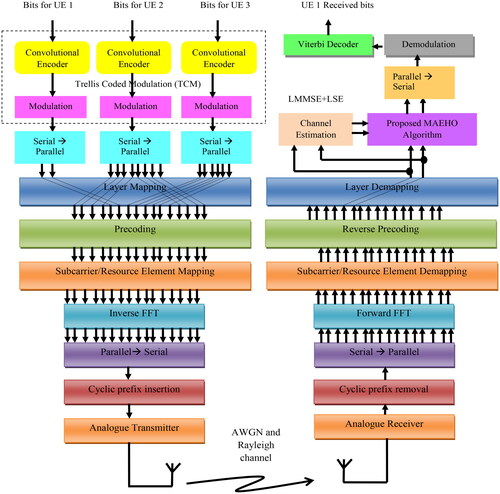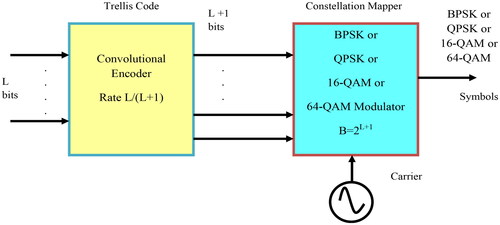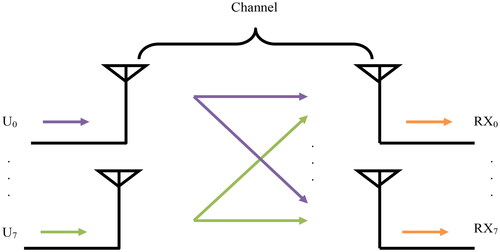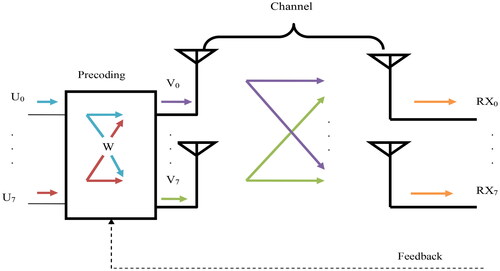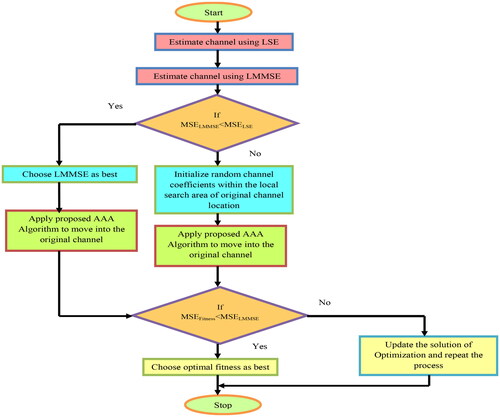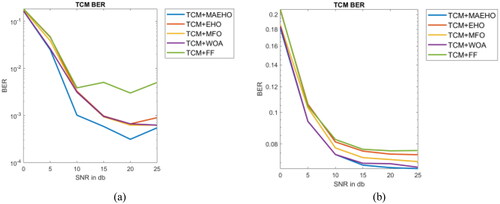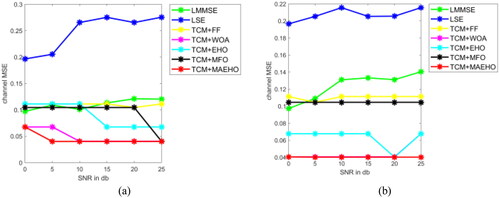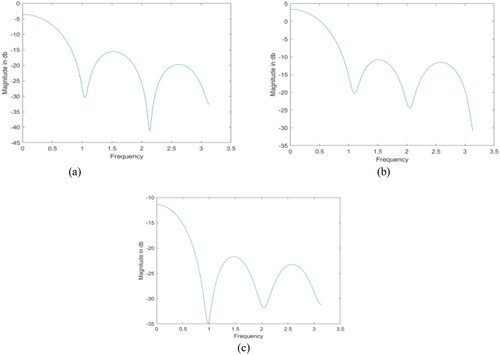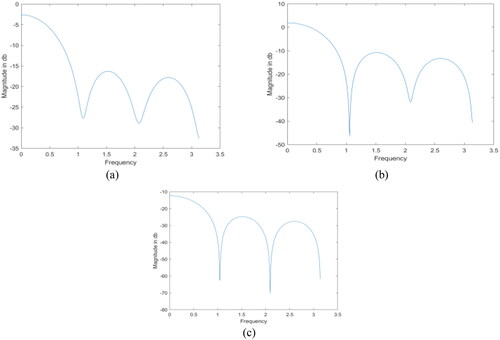 ?Mathematical formulae have been encoded as MathML and are displayed in this HTML version using MathJax in order to improve their display. Uncheck the box to turn MathJax off. This feature requires Javascript. Click on a formula to zoom.
?Mathematical formulae have been encoded as MathML and are displayed in this HTML version using MathJax in order to improve their display. Uncheck the box to turn MathJax off. This feature requires Javascript. Click on a formula to zoom.Abstract
Data transfer in a wireless channel environment is plagued by numerous security issues and power transmission loss. Channel state information is crucial to attaining the performance benefit of reconfigurable intelligent surfaces (RISs) in wireless systems. Because of the Doppler effect, mobility makes accurate channel estimate (CE) more difficult. The parameter estimation approach is employed as an alternative to direct estimation in the channel matrix to address the aforementioned problems. Also, to lower the Mean Square Error (MSE) between the estimated and original channel, training-based CE, such as Linear Minimum Mean Square Error (LMMSE), and Least Square Error (LSE), are widely used in some wireless standards. To optimize the channel, certain intelligent optimized strategies are presented. For the Optimal CE, a Trellis Coded Modulation (TCM) with hybrid optimization in LMMSE has been provided. Moth amalgamated Elephant Herding Optimization (MAEHO) algorithm is the proposed hybrid optimization. Finally, the performance of the accepted model is determined in comparison to other existing techniques using a variety of metrics.
1. Introduction
Channel Estimation (CE) is the process of estimating the channel matrix that includes the coefficients of the channel in an estimated manner and then computes the original coefficients of the channel (Chen and Lam Citation2018). Moreover, the CE is divided into Pilot/training based semi-blind among the CE training with more prevalent and reliable wireless standards (Yuan and Kam Citation2017; Xie, Chen, and Liu Citation2017). Here, the pilot-based CE is splitted into Least Square Error (LSE) and Linear Minimum Mean Squares Error (LMMSE). In addition, the LSE is simple for implementing as it has a large Mean Square Error (MSE) (Uwaechia and Mahyuddin Citation2019). Likewise, LMMSE is superior to the LSE with low MSE; however, it is more difficult as it has matrix inversion calculation and the channel gets varied each time based on the fading phenomenon (Bazzi et al. Citation2019; Huang et al. Citation2018).
The channel estimators are required to provide the Channel State Information (CSI) of the link from the relay to the destination and also from the source to the relay, in which the relay would use the CSI destination for demodulating the received signal coherently or to set the amplification factor (Wu, Liu, and Wang Citation2018; Shalavi, Atashbar, and Feghhi Citation2020). In wireless communications, the CE provides higher-standing issues. The 2 channel gains are multiplied in both hops with one another at the destination, and this is due to the relaying operation of traditional relaying approaches (Zhang et al. Citation2018). In the destination phase, the receiver needs the two-channel gain product for demodulation. In particular, under different conditions of relaying, the channel gain product in the packet link and the supplier link of channel gain is evaluated. Some of the simple LS estimators are implemented as the product of the two-channel gain (Bhandari and Jadhav Citation2019; Almamori and Mohan Citation2020). In some of the traditional models, the ML method is adopted for estimating the channel gains at the relay (Akbarpour-Kasgari and Ardebilipour Citation2019).
Recently, more research is done for relaying the energy harvesting process based on the CE. Moreover, the difference between energy harvesting and relaying was based on the operations of energy harvesting at the relay, the transmission power becomes the channel gain function in the source-to-relay link of the relay node (Li et al. Citation2020; Kaur, Khosla, and Sarin Citation2019). The integrated Multiple-Input Multiple-Output Orthogonal- Frequency Division Multiplex Multi-User Detection (MIMO-OFDM MUD) algorithms (Thomas and Rangachar Citation2018; Srinivas and Santhirani Citation2020; AlBalushi Citation2019) are the significant model in the MAI diminishing effects. The OFDM is used to combat the ISI effectually with intrinsic broadband transmissions; whereas, the MIMO is performed to ameliorate the suppressing interference/channel SE (Ali et al. Citation2021). The vast BS affords the CE more than the user station of an MU scenario (Su and Wang Citation2019; Alamir, Esmaiel, and Hussein Citation2020). Many intelligent or optimization methods (Dhumane, Markande, and Midhunchakkaravarthy Citation2020; Beno et al. Citation2014; Rathod Citation2020; Nair and Kanakasabapathy Citation2019; Roy Citation2020) are determined for minimizing the channel MSE and also for mitigating the effect of fading. CE plays a significant role in the system design for traditional relaying and energy harvesting relaying. The main objectives are:
The training-based CE including Linear Minimum Mean Square Error (LMMSE) and Least Square Error (LSE) are prevalent in some wireless standards to lower the Mean Square Error (MSE) among the estimated and original channel.
Proposing a MAEHO, Trellis Coded Modulation used with hybrid optimized LMMSE for channel estimation.
The suggested technique improves performance by addressing issues with sluggish convergence and quickly entering local optima.
In this paper, Section 2 indicates the literature works on LMMSE based CE method. Section 3 discussed the overall framework of the proposed model. Section 4 portrays proposed hybrid optimization algorithms for channel estimation. The findings and associated analyses are presented in Section 5. Finally, Section 6 represents the work’s conclusion.
2. Literature Review
2.1. Related Works
In Charrada (Citation2018) has developed an LMMSE-SVR method with a maximum-speed 3GPP LTE downlink-coded CE model. Moreover, the LMMSE-SVR model was applied for estimating, and fast fluctuations tracking was obtained through the 3GPP realistic EVA approach with the Doppler effect. Further, the interpolation at data symbols and the CE at pilot symbols were integrated into the LMMSE-SVR model without and with the turbo coding approach. Lastly, the results of the suggested approach have achieved high-speed estimation, increased throughput, and improved QoS than other conventional schemes.
In Li et al. (Citation2018) has examined the CE for relaying wireless energy harvesting. The Rayleigh fading channels based on time-varying with the Jakes approach were determined in the proposed model. Further, the energy harvestings strategies such as PS and TS were developed. Moreover, the relaying of fixed gain was computed to the relaying variable gain; however, the SNR and the BER were examined. The outputs of the conventional methods are proved over fewer signal-to-noise ratios and minimum BER, correspondingly.
In Dai et al. (Citation2021) has determined a CE approach with the decomposition of lower dimension for millimeter-wave massive MIMO models. The channel matrix estimation was decomposed into channel gain information and angle information estimation for attaining the maximum estimation accuracy. Further, the received signals were decomposed using the minimization of dimensionality, which separates the transmitting end and receiving end angles. Here, the off-grid error was observed as the adjustment parameter, and the SSR scheme was used for acquiring the initial sparse support set. In the end, the effectiveness of the presented model attained reduced training resources, low costs, and efficiency is high.
In Boukhedimi, Kammoun, and Alouini (Citation2019) have suggested the UL theoretical analysis of a massive MIMO approach with Rician fading and correlation of each-user channel by the two processing approaches. The LMMSE receiver with training-based imperfect CE was examined in the proposed work. Moreover, the statistical combining technique was implemented, which was suitable for the strongest LoS components in the environments. Here, the asymptotic approximations of the UL- SE in closed form were obtained through multi-cell and single settings of each approach. Additionally, it was exploited for determining the optimal number of training symbols at reduced Rician factors. Lastly, the simulation results of the adopted method achieves low Rician factors, higher SE gains, and stronger LoS signals, respectively.
In Xiong, Wei, and Zhang (Citation2018) have suggested an LMMSE-based receiver for the uplink of massive MIMO approaches with random IQ Imbalance. Furthermore, the proposed work has examined the effective channel with statistic property by IQI parameters modeling, in which the CSI and IQI parameters were included. Therefore, an LMMSE-based receiver was determined for the data detection and CE. In addition, the asymptotic analysis based on tightness has achieved the sum rate for the adopted model with the outcomes received from the random matrix theory. Finally, compared to other conventional systems, the results obtained of the developed system showed less performance loss and better BER performance.
In Ali et al. (Citation2020) have proposed an “NDMRS-assisted transform-domain” with fewer complexities based on CE models known as D-LS and RS-LS. Moreover, the sub-optimal estimator stemmed from the CE filter known as LMMSE-A. Initially, at pilot frequencies, the channel response was estimated by the traditional LS models and applied certain time-domain operations for error suppressing the LS estimation. Here, the CE was obtained for the other OFDM symbols within an NB-IoT sub frame. Finally, the stimulation outcomes of the adopted model have proven better throughput, minimum error, and low computational complexity.
In Sorna Keerthi and Meena Alias Jeyanthi (Citation2018) have implemented the trellis-coded firefly-optimized LMMSE model for the CE. Moreover, the FA has an easy implementation, low complexity, and the subdivision of groups automatically for finding the global/local optima, and with multimodality, it deals the ability. Moreover, the symbols of trellis coded were transmitted to the mapping of layer and thus mapped the modulated symbols to several layers of transmission of the transmitted antenna count. Further, the symbols of layer mapped were multiplied with a precoding matrix and their value was dissimilar for various types of modulations. In the end, the adopted method outcomes have achieved low complexity, high spectral efficiency, and reduced error, respectively.
In Jeya and Amutha (Citation2019) have proposed an OSBS CE approach for MU-MIMO-based OFDM. Initially, the QPSK modulation was proposed for modulating an input signal on the transmitter block. Moreover, the PSA was used to mitigate the ISI. Here, the IFFT operation was performed at every transmitter for symbol mapping. Further, the symbols were transmitted in the multipath channel from the transmitter to the antenna receivers via the AWGN adding. In addition, the CE was performed through the OSBS algorithm, and the EDE algorithm was employed for minimizing the cost function. Finally, compared to other existing models, the suggested model’s findings demonstrated lower BER, increased channel capacity, and low SNR.
2.2. Review
illustrates the related works of LMMSE-based CE. Initially, the LMMSE-SVR method was deployed (Charrada Citation2018), which presents high-speed estimation, increased throughput, and improved QoS; however, the learning step complexity was not reduced. Jakes’s model was exploited by Li et al. (Citation2018) which offers fewer signal-to-noise ratios and minimum BER, but it needs to consider the choice of the PS factor. Moreover, the LSE algorithm deployed by Dai et al. (Citation2021) offers reduced training resources, low costs, and high spectral efficiency. Nevertheless, it needs to develop low-resolution super-resolution CE schemes. Likewise, the Massive MIMO system was exploited by Boukhedimi, Kammoun, and Alouini (Citation2019), which offers low Rician factors, higher SE gains, and stronger LoS signals. However, the processing approach does not constitute the achievable capacity limitation. A massive MIMO system was exploited by Xiong, Wei, and Zhang (Citation2018) that has a small loss, and better BER performance; however, the adopted scheme does not need the IQI parameter’s exact value. In addition, RS-LS and D-LS algorithms were introduced by Ali et al. (Citation2020), which offer better throughput, minimum error, and low computational complexity. However, NDMRS and NPUSCH hopping were not considered in the adopted model. Trellis Coded FF Optimized LMMSE model was suggested by (Sorna Keerthi and Meena Alias Jeyanthi Citation2018) which offer low complexity, high spectral efficiency, and reduced error. However, the heuristic algorithm does not give optimum solutions. Finally, the OSBS-CE algorithm was implemented (Jeya and Amutha Citation2019), which offers improved channel capacity, and low SNR, but needs to consider more transmitters and also receivers in this work. Such limitations were taken into account for the consideration of LMMSE-based CE in the suggested approach is more effectively.
Table 1. Review on conventional LMMSE based CE models: features and challenges.
3. Overall Framework of the Proposed Model
3.1. System Model
This work intends to propose an optimal CE in Trellis Coded modulation using hybrid optimization. For further optimization purposes, the new MAEHO algorithm is introduced by the combination of the MFO and EHO algorithms. depicts the architectural diagram of the presented method. From , the binary information from various users is given as the input to the TCM block (Sorna Keerthi and Meena Alias Jeyanthi Citation2018; Thune and Haridas Citation2019a; Thune and Haridas Citation2016; Thune and Haridas Citation2019b; ATCM-System: Advanced Trellis Coded Modulation System (patent) (n.d.). The convolutional encoder and modulation process is performed in the TCM block.
illustrates the TCM model. Moreover, the convolutional encoder along with its coding rate is presented in the TCM, and it is given in EquationEq. (1)(1)
(1) .
(1)
(1)
The convolutional encoder, denotes the input bit count and
refers to the output bit count as determined in EquationEq. (1)
(1)
(1) . Furthermore, the
-ary signal mapper is present in the TCM that maps the input points
into the higher constellation of
points. In addition, the advantages of TCM include set partitioning provides sequence coding, maximum bit rate with no alteration in the symbol rate, and invariant phase. Euclidean distance rather than hamming distance contains soft decision decoding and higher efficient bandwidth. Moreover, in the Convolutional encoder, the bits are encoded with a code rate of 1/2 and it is modulated digitally through any one of the methods such as 64-QAM, QPSK, 16-QAM, and BPSK, correspondingly. For each bit input, the code rate is referred to as 1/2 and the output of the convolutional encoder is two bits. It transmits “1 bit/symbol for BPSK, 2 bits/symbol for QPSK, 4 bits/symbol for 16-QAM and 6 bits/symbol for 64-QAM”, respectively.
The mapping level procedure receives the trellis-coded signals. Based on how many distributing antennae there are, the symbols modulated are mapped into certain transmission layers. The mapped layer symbols are multiplied by the precoding matrix. Still, the values of elements in the precoding matrix are dissimilar for various types of modulation used in this process.
The process that develops transmit diversity system through the information weighting is Precoding. Further, the coded information is transmitted to the receiver for the channel pre-knowledge. At the same time, the multiple transmitters in MU-MIMO are communicated with the SDMA (i.e.,.,), multiple receivers. and illustrate the 8 × 8 MIMO without and with Precoding.
Precoding is performed in a linear or non-linear manner. Additionally, reasonable performance is attained by the process of linear precoding with low complexity that consists of transmit Wiener precoding, ZF precoding, and MRT precoding. The precoder output is expressed in EquationEq. (2)(2)
(2) .
(2)
(2)
In EquationEq. (2)(2)
(2) ,
…,
refers to the outputs of layer mapping in the LTE-A downlink scheme, W specifies the precoding matrix, and
…,
denotes the precoding outputs. Moreover, linear precoding is used due to its maximum transmission rate and low complexity for the 8 × 8 MIMO LTE-A downlink scheme.
The users’ information present in the resource/subcarrier element mapping is distributed to various subcarriers and the user symbols in various subcarriers are allocated to form the resource block. Similarly, the mapping in the subcarrier is categorized into interleaved and localized subcarrier mapping. illustrates the interleaved subcarrier mapping known as interleaved—OFDMA. Here, the subcarriers are assigned to the users in sequence and it is continual. G Users are given sub channels that are systematically stage rotated and shared equally over a given band. represents the localized subcarrier mapping model known as localized OFDMA. The subcarriers are mapped neighboring to each other in the localized subcarrier mapping. The merit of localized OFDMA indicates the possibility of multiuser diversity that provides better performance and higher system capacity.
The interleaved-OFDMA is selected as the type of subcarrier as it is raised slightly at high SNR with low BER than the localized-OFDMA. Moreover, the resource blocks are processed via IFFT which converts the frequency domain signals to the time domain information. The cyclic prefix is merged with the symbols for reducing the ISI, after IFFT. Further, the CP adder and IFFT in the LTE-A system are known as the OFDM mapper. From the LTE-A downlink transmitter, the time-varying signals are transmitted via a Rayleigh faded AWGN channel which affects the signals through the multipath fading effects.
The fading signals are received in the LTE-A downlink receiver and the combined cyclic prefix part in the source is detached. In this method, FFT is taken into consideration for translating time-domain signals into frequency-domain signals. Now, the user 1 data is recreated in the destination. Moreover, the mobile user equipment includes the MAEHO-based optimized CE for recovering the channel coefficients in an efficient way. The reverse precoding splits the obtained symbols via the precoding matrix and hence it selects from the user 1 data for reconstructing the specific layer. The Viterbi algorithm is used by the Trellis decoder for detecting and demodulating the User1 data. Nevertheless, the data is effectively demodulated as it includes high BER. The CSI present in the LTE-A system is estimated to reduce the BER. Moreover, the pilot/training-based CE consists of LSE and LMMSE. The LSE is easy to implement and it does not use the channel statistics but it has maximum MSE. LMMSE is more complex to implement and it has low MSE; still, the matrix inversion is considered each time for varying channels in the wireless environment. Moreover, the trellis-coded LMMSE-based MAEHO algorithm is introduced for reducing the network MSE, bringing the channel coefficients more in line with the typical network values and obtaining efficient CE.
4. Proposed Hybrid Optimization Algorithms for Channel Estimation
4.1. Proposed CE Framework
The proposed CE uses a trellis-coded MAEHO algorithm-based LMMSE system which minimizes the effects of multipath fading and provides low MSE. The suggested approach steps are:
Step 1: Estimate the channel using LSE.
Step 2: Estimate the channel using LMMSE.
Generally, the LMMSE provides enhanced performance than LSE with low MSE. Still, it involves the calculation of an inverse matrix every time. Moreover, the time-varying channel was based on multipath fading in the wireless environment. In addition, the location of channel coefficients in space has diverged its position owing to the multipath fading effects.
Step 3: Check, if the MSE of LMMSE is low than the MSE of LSE, it chooses LMMSE as best. Then, apply the hybrid MAEHO algorithm to move the channel coefficients position to the original channel position. Else, initialize the random channel coefficients of the original channel location within the immediate searching region, and their projected fitness levels.
Step 4: If the MSE (fitness) is lower than the MSE of LMMSE, then it chooses the optimal fitness as best. Otherwise, update the solutions of optimization and repeat the process. represents the flowchart of the proposed CE algorithm.
4.2. Fitness Function
The objective or fitness function of the adopted MAEHO approach is expressed in EquationEq. (3)(3)
(3) .
(3)
(3)
In EquationEq. (3)(3)
(3) ,
indicates the coefficients of the original channel estimation, and
refers to the channel coefficients passé.
4.3. Proposed MAEHO Algorithm
EHO intends to analyze the optimal value functions or near-optimal values. Even though, the traditional EHO (Elhosseini et al. Citation2019) algorithm gives superior performance; the disadvantage is that it does not use the essential data for finding current and future searches. Therefore, the proposed MAEHO model has been developed as the capable one for several search issues (Beno et al. Citation2014). Typically, elephants live in social groups made up of numerous clans, each of which is headed by a matriarch. Once they reach adulthood, the male elephant lives apart from these groups. The EHO algorithm is decided into three key rules for emulating and performing the qualities of the elephants.
The number of elephants in each clan, which is part of the overall elephant population, is known.
Some male elephants reside separately, a great distance from the clan groups.
Each tribe of elephants has a matriarch who is regarded as its leader.
The population of elephants is produced at random and divided into numerous clans according to fitness. Each clan’s update is carried out separately.
4.3.1. Clan Updating Operators
Every single elephant in the clan lives under the headship of the matriarch and the next position is determined through the matriarch
EquationEquation (4)
(4)
(4) represents the update of the elephant
in clan
(4)
(4)
In EquationEq. (4)(4)
(4) ,
denotes the newly updated clan,
indicates the scaling factor that influences the matriarch on
for
and
refers to the position of the previous elephant
in the clan
specifies the matriarch
as the fittest elephant individual in the
clan, and
In each clan, the fittest elephant is not updated as per EquationEq. (4)
(4)
(4) , (i.e.,),
The procedure of the adopted MAEHO model is as follows: Conventionally, each clan update of EHO is performed individually. As per the proposed MAEHO algorithm, the fittest elephant in each clan is updated as per the MFO update, and it is defined in EquationEq. (5)(5)
(5) . Here,
indicates the center of the clan
the
is performed based on the update of MFO as per EquationEqs. (6)
(6)
(6) and Equation(7)
(7)
(7) .
(5)
(5)
Here, [0,1] factor establishes the influence of the
on
to generate the new individual. This defines under certain conditions: (1) The matriarch’s current position does not depend on the previous position that would not make any sense. (2) The matriarch moves closer to the origin only if
is small. (3) If
is large, the matriarch is moved closer to the clan center.
Moreover, the update of the MFO algorithm is determined in EquationEq. (6)(6)
(6) , where,
is a constant that defines the shape of the logarithmic spiral, and
denotes the random number in [-1,1]. Further, the distance
of
moth for the
flame is calculated as per EquationEq. (7)
(7)
(7) , here,
indicate the
moth, and
indicates the
flame.
(6)
(6)
(7)
(7)
4.3.2. Separating Operator
After they reach adulthood, male elephants live apart from their groups. Also, the fitness of each elephant for each generation is used to determine the removal process using the separating operator. Elephant persons are presumptively the least appropriate to enhance EHO search capabilities. As per the adopted model logic, for to
the new elephant individual is generated as
Here,
indicates the number of all clans (for all clans in elephant population). Furthermore, EquationEq. (8)
(8)
(8) represents the separating operator for every generation. For ensuring the population diversity, a new separating operation is used.
(8)
(8)
In EquationEq. (8)(8)
(8) ,
and
are the upper and lower bound elephant individuals’ position, and
is a random distribution in the range [0, 1].
is the worst elephant individual in clan
If
then replace the worst by
If
then replace the worst by
where,
denotes the probability value, set
Moreover, in Algorithm 1,
indicates number of clans (for all elephants in clan
). Algorithm 1 contains the accepted MAEHO model.
Algorithm 1:
Pseudo code of proposed MAEHO model
Initialization
Compute the elephant fitness
Repeat
Elephants arrangement based on their fitness
Clan updating
For to
do
For to
do
If then
Proposed update of and generate
by EquationEq. (5)
(5)
(5) .
Else
Update and generate
by EquationEq. (4)
(4)
(4) .
End if
End for
End
Separating operator
For to
do
Generate the new elephant individual
Proposed update is given in EquationEq. (8)(8)
(8)
If then
Replace the worst by
Else if then
Replace the worst by
End if
End for
Evaluate the population by the new update positions
Until
5. Results and Discussions
5.1. Simulation Procedure
The suggested TCM with a hybrid MAEHO model in LMMSE was implemented in MATLAB and their results are proved. Moreover, the performance of the adopted TCM + MAEHO model was computed to the traditional schemes like TCM + EHO (Elhosseini et al. Citation2019), TCM + MFO (Mirjalili Citation2015), TCM + WOA (Mirjalili and Lewis Citation2016), and TCM + FF (Wang et al. Citation2017), correspondingly. Moreover, the evaluation process are examined for PSK and QAM in regards to particular actions like BER, Channel MSE, and magnitude response of LMMSE and LSE channel matrix, respectively.
5.2. Convergence Analysis
illustrates the comparison of the proposed TCM + MAEHO technique’s convergence to other current methods for iterations between 0 and 30. With more iterations, the cost function gradually decreases, as can be seen from the chart. Also, compared to other existing models, the proposed TCM + MAEHO technique has attained minimum cost values like TCM + EHO, TCM + MFO, TCM + WOA, and TCM + FF, respectively. Further, in , the convergence of the adopted TCM + MAEHO model attains lower values (∼0.0003) at the 15th iteration for PSK; whereas, the traditional models attain higher values like TCM + EHO (∼0.0043), TCM + MFO (∼0.007), TCM + WOA (∼0.0041), and TCM + FF (∼0.0028), respectively. The convergence of the adopted TCM + MAEHO method in at the 5th iteration is 97.05%, 98%, 95.23%, and 93.33% better than the existing models like TCM + EHO, TCM + MFO, TCM + WOA, and TCM + FF, respectively for QAM. According to the convergence analysis graph, the TCM + MAEHO approach that was used has produced better results.
5.3. BER Analysis
illustrates the BER analysis of the proposed TCM + MAEHO model over other traditional models for PSK and QAM. As the SNR value increases, the BER is minimized. In addition, the adopted MAEHO model holds more minimum BER values than other models. Moreover, the BER of the adopted TCM + MAEHO model attains least values (∼) for PSK at 10db SNR than other traditional models like TCM + EHO, TCM + MFO, TCM + WOA, and TCM + FF, respectively in . The BER of the adopted TCM + MAEHO method for QAM at 15db SNR attains better BER (∼0.02) than the existing models like TCM + EHO, TCM + MFO, TCM + WOA, and TCM + FF, correspondingly.
5.4. Analysis of Channel MSE
The analysis based on channel MSE of the proposed TCM + MAEHO model over other existing models for PSK and QAM is represented in . The adopted TCM + MAEHO model holds lower channel MSE values (∼0.04) with better resultant outcomes than other traditional models like TCM + EHO, TCM + MFO, TCM + WOA, and TCM + FF, correspondingly at 20db SNR for PSK in . Moreover, the proposed TCM + MAEHO method attains constant channel MSE (i.e.,.,), the lowest value of 0.04 than the existing models like TCM + EHO, TCM + MFO, TCM + WOA, and TCM + FF, respectively for QAM.
5.5. Analysis of Magnitude Response
The analysis based on the magnitude response of the PSK and QAM in terms of the LMMSE channel matrix, LSE channel matrix, and proposed TCM + MAEHO model is shown in and . Moreover, the magnitude response of the PSK and QAM is calculated. Here, the frequency value ranges from 0 to 3.5. In , the QAM of the adopted TCM + MAEHO model holds magnitude at the range (∼-42db) for frequency 2.
5.6. Statistical Analysis
The statistical analysis of the proposed TCM + MAEHO method over other existing models for PSK and QAM modulation is described in and . “Since the meta-heuristic algorithms are stochastic in nature and also to assure the proper comparison, it is fixed to execute algorithms several times to obtain the statistics of the objective function”. On analyzing the table, the proposed TCM + MAEHO method shows superior outcomes than other existing models like TCM + MFO, TCM + EHO, TCM + WOA, and TCM + FF, respectively. The PSK modulation of the proposed TCM + MAEHO method under the best-case scenario has attained better MSE values (0.00082) than other conventional models like MFO, EHO, WOA, and FF, respectively in . For the mean case scenario, the MSE of the proposed TCM + MAEHO method for QAM is 95.40%, 95.97%, 96.61%, and 99.26% superior to other existing models like TCM + MFO, TCM + EHO, TCM + WOA, and TCM + FF, correspondingly.
Table 2. Statistical analysis: proposed vs. traditional models for PSK.
Table 3. Statistical analysis: proposed vs. traditional models for QAM.
5.7. Error Analysis
and explain the error analysis of the proposed TCM + MAEHO model over other existing schemes in terms of certain measures like MSE, RMSE, MAE, and PSNR, correspondingly. From the table, the PSK modulation of the presented TCM + MAEHO system achieved lesser RMSE values (0.010825), which is a superior performance vs comparable models like TCM + MFO (0.029974), TCM + EHO (0.025), TCM + WOA (0.01875), and TCM + FF (0.023385), respectively. Similarly, the QAM of the adopted TCM + MAEHO model is 10.15%, 4.929%, 1.68%, and 13.45% superior to the conventional models such as TCM + MFO, TCM + EHO, TCM + WOA, and TCM + FF, correspondingly in terms of MSE.
Table 4. Error analysis: proposed vs. traditional models for PSK.
Table 5. Error analysis: proposed vs. traditional models for QAM.
5.8. Computational Analysis
depicts the time complexity model. The analysis of the suggested approach is minimum (∼152.32) when compared to the existing model like MFO (∼232.14), EHO (∼212.45), WOA (∼198.75) and FF (∼187.98). The suggested model’s superior to the other current models is thus established.
Table 6. Analysis on computational time.
6. Conclusion
In this paper, a TCM with hybrid LMMSE optimization for the optimal CE is presented. Furthermore, the proposed hybrid optimization used the MAEHO algorithm. Finally, the effectiveness of the proposed approach was calculated in comparison to other current systems using a variety of criteria. On observing the graph, the convergence of the adopted TCM + MAEHO method attains lower values (∼0.0003) at the 15th iteration for PSK; whereas, the traditional models attain higher values like TCM + EHO (∼0.0043), TCM + MFO (∼0.007), TCM + WOA (∼0.0041), and TCM + FF (∼0.0028). The BER of the suggested TCM + MAEHO method for QAM at 15db SNR attains better BER (∼0.02) than the existing models like TCM + EHO, TCM + MFO, TCM + WOA, and TCM + FF, correspondingly. The adopted TCM + MAEHO model holds lower channel MSE values (∼0.04) with better resultant outcomes than conventional schemes such as TCM + EHO, TCM + MFO, TCM + WOA, and TCM + FF, correspondingly at 20db SNR for PSK. For the mean case scenario, the QAM of the proposed TCM + MAEHO method was 95.40%, 95.97%, 96.61%, and 99.26% superior MSE to other existing models like TCM + MFO, TCM + EHO, TCM + WOA, and TCM + FF, correspondingly.
| Nomenclature | ||
| AWGN | = | Additive White Gaussian Noise |
| BER | = | bit error rate |
| BPSK | = | binary phase shift keying |
| BS | = | base station |
| CE | = | channel estimation |
| CSI | = | channel state information |
| D-LS | = | de-noising LS |
| EDE | = | enhanced differential evolution |
| EHO | = | elephant herding optimization |
| EVA | = | extended vehicular A |
| FA | = | Firefly algorithm |
| IFFT | = | inverse fast Fourier transforms |
| IoT | = | internet of things |
| IQI | = | inphase/quadrature-phase imbalance |
| ISI | = | inter-symbol interferences |
| LMMSE | = | linear minimum mean squares error |
| LoS | = | line-of-sight |
| LS | = | least squares |
| LSE | = | least square error |
| LTE | = | long term evolution |
| MAEHO | = | moth amalgamated elephant herding optimization |
| MAI | = | multi-access interference |
| MFO | = | moth flame optimization |
| MIMO | = | multiple-input multiple-output |
| ML | = | maximum likelihood |
| MRT | = | maximum ratio transmission |
| MSE | = | mean square error |
| MU | = | multi-user |
| MUD | = | multi-user detection |
| MUI | = | multiuser interference |
| NDMRS | = | narrowband demodulation reference signal |
| OFDM | = | orthogonal- frequency division multiplex |
| OSBS | = | optimized semi-blind sparse |
| PS | = | power-splitting |
| PSA | = | pulse shaping algorithm |
| QAM | = | quadrature amplitude modulation |
| QoS | = | quality of service |
| QPSK | = | quadrature phase shift keying |
| RS-LS | = | random sorting least squares |
| SE | = | spectral efficiency |
| SNR | = | signal to noise ratio |
| SSR | = | sparse signal recover |
| SVR | = | support vector machine regression |
| TCM | = | Trellis coded modulation |
| TS | = | time-switching |
| UL | = | uplink |
| ZF | = | zero-forcing |
Disclosure statement
No potential conflict of interest was reported by the author(s).
References
- Akbarpour-Kasgari, A., and M. Ardebilipour. 2019. “Distributed Compressed Sensing-Based Channel Estimation and Pilot Allocation for MIMO Relay Networks.” Iranian Journal of Science and Technology, Transactions of Electrical Engineering 43 (S1): 159–170. https://doi.org/10.1007/s40998-018-0136-7
- Alamir, A., H. Esmaiel, and H. S. Hussein. 2020. “Efficient Optical MIMO–OFDM Channel Estimation Based on Correntropy Compressive Sensing.” Wireless Personal Communications 115 (3): 1955–1971. https://doi.org/10.1007/s11277-020-07663-x
- AlBalushi, F. M. 2019. “Chaotic Based Hybrid Artificial Sheep Algorithm-Particle Swarm Optimization for Energy and Secure Aware in WSN.” Journal of Networking and Communication Systems 2 (2): 37–48.
- Ali, W., Y. Li, N. Ahmed, W. Ali, and M. Kashif. 2021. “A Novel Application of Pattern Search Algorithm for Efficient Estimation of Channel State Information in MIMO Network.” Wireless Personal Communications 116 (1): 325–340. https://doi.org/10.1007/s11277-020-07717-0
- Ali, M. S., Y. Li, S. Chen, and F. Lin. 2020. “On Improved DFT-Based Low-Complexity Channel Estimation Algorithms for LTE-Based Uplink NB-IoT Systems.” Computer Communications 149: 214–224. https://doi.org/10.1016/j.comcom.2019.10.022
- Almamori, A., and S. Mohan. 2020. “Estimation of Channel State Information (CSI) in Cell-Free Massive MIMO Based on Time of Arrival (ToA).” Wireless Personal Communications 114 (2): 1825–1831. https://doi.org/10.1007/s11277-020-07450-8
- ATCM-System: Advanced Trellis Coded Modulation System(patent). n.d.
- Bazzi, Samer, Stelios Stefanatos, Luc Le Magoarou, Salah Eddine Hajri, Mohamad Assaad, Stephane Paquelet, Gerhard Wunder, and Wen Xu. 2019. “Exploiting the Massive MIMO Channel Structural Properties for Minimization of Channel Estimation Error and Training Overhead.” IEEE Access. 7: 32434–32452. https://doi.org/10.1109/ACCESS.2019.2903654
- Beno, M. M., V. I. R, S. S. M, and B. R. Rajakumar. 2014. “Threshold Prediction for Segmenting Tumour from Brain MRI Scans.” International Journal of Imaging Systems and Technology 24 (2): 129–137. https://doi.org/10.1002/ima.22087
- Bhandari, R., and S. Jadhav. 2019. “Novel Spectral Efficient Technique for MIMO-OFDM Channel Estimation with Reference to PAPR and BER Analysis.” Wireless Personal Communications 104 (4): 1227–1242. https://doi.org/10.1007/s11277-018-6077-7
- Boukhedimi, I., A. Kammoun, and M. S. Alouini. 2019. “LMMSE Receivers in Uplink Massive MIMO Systems with Correlated Rician Fading.” IEEE Transactions on Communications 67 (1): 230–243. https://doi.org/10.1109/TCOMM.2018.2869586
- Charrada, A. 2018. “SVM Based on LMMSE for High-Speed Coded OFDM Channel with Normal and Extended Cyclic Prefix.” Physical Communication 29: 288–295. https://doi.org/10.1016/j.phycom.2018.07.008
- Chen, H., and W. H. Lam. 2018. “Training Based Two-Step Channel Estimation in Two-Way MIMO Relay Systems.” IEEE Transactions on Vehicular Technology 67 (3): 2193–2205. https://doi.org/10.1109/TVT.2017.2765660
- Dai, R., Y. Liu, Q. Wang, Y. Yu, and X. Guo. 2021. “Channel Estimation by Reduced Dimension Decomposition for Millimeter Wave Massive MIMO System.” Physical Communication 44: 101241. https://doi.org/10.1016/j.phycom.2020.101241
- Dhumane, A. V., S. D. Markande, and D. Midhunchakkaravarthy. 2020. “Multipath Transmission in IoT Using Hybrid Salp Swarm-Differential Evolution Algorithm.” J. Network. Commun. Syst 3: 20–30.
- Elhosseini, M. A., R. A. El Sehiemy, Y. I. Rashwan, and X. Z. Gao. 2019. “On the Performance Improvement of Elephant Herding Optimization Algorithm.” Knowledge-Based Systems 166: 58–70. https://doi.org/10.1016/j.knosys.2018.12.012
- Huang, H., J. Yang, H. Huang, Y. Song, and G. Gui. 2018. “Deep Learning for Super-Resolution Channel Estimation and DOA Estimation Based Massive MIMO System.” IEEE Transactions on Vehicular Technology 67 (9): 8549–8560. https://doi.org/10.1109/TVT.2018.2851783
- Jeya, R., and B. Amutha. 2019. “Optimized Semiblind Sparse Channel Estimation Algorithm for MU-MIMO OFDM System.” Computer Communications 146: 103–109. https://doi.org/10.1016/j.comcom.2019.07.018
- Kaur, H., M. Khosla, and R. K. Sarin. 2019. “Hybrid Type-2 Fuzzy Based Channel Estimation for MIMO-OFDM System with Doppler Offset Influences.” Wireless Personal Communications 108 (2): 1131–1143. https://doi.org/10.1007/s11277-019-06460-5
- Li, S., G. Cao, L. Jin, and H. Wu. 2020. “Channel Estimation Based on the PSS-MUSIC for Millimeter-Wave MIMO Systems Equipped with Co-prime Arrays.” EURASIP Journal on Wireless Communications and Networking 2020 (1): 1–11. https://doi.org/10.1186/s13638-020-1637-4
- Li, L., M. Mao, N. Cao, and J. Li. 2018. “LMMSE Channel Estimation for Wireless Energy Harvesting AF Relaying.” Physical Communication 27: 133–142. https://doi.org/10.1016/j.phycom.2018.02.002
- Mirjalili, S. 2015. “Moth-Flame Optimization Algorithm: A Novel Nature-Inspired Heuristic Paradigm.” Knowledge-Based Systems 89: 228–249. https://doi.org/10.1016/j.knosys.2015.07.006
- Mirjalili, S., and A. Lewis. 2016. “The Whale Optimization Algorithm.” Advances in Engineering Software 95: 51–67. https://doi.org/10.1016/j.advengsoft.2016.01.008
- Nair, R., and P. P. Kanakasabapathy. 2019. “Hybrid PSO-BF Algorithm for Economic Dispatch of a Power System.” J. Comput. Mech., Power Syst. Control 2 (4): 28–37.
- Rathod, S. 2020. “Hybrid Metaheuristic Algorithm for Cluster Head Selection in WSN.” Journal of Networking and Communication Systems 3 (4): 101504.
- Roy, M. R. G. 2020. “Economic Dispatch Problem in Power System Using Hybrid PSO and Enhanced Bat Optimization Algorithm.” Journal of Computational Mechanics Power System and Control (JCMPS) 3 (3): 27–33.
- Shalavi, N., M. Atashbar, and M. M. Feghhi. 2020. “Downlink Channel Estimation of FDD Based Massive MIMO Using Spatial Partial-Common Sparsity Modeling.” Physical Communication 42: 101138. https://doi.org/10.1016/j.phycom.2020.101138
- Sorna Keerthi, R., and K. Meena Alias Jeyanthi. 2018. “Effortless Trellis Coded Firefly Optimized LMMSE Based Channel Estimation for LTE-Advanced Downlink.” Journal of Intelligent & Fuzzy Systems 34 (6): 4331–4344. https://doi.org/10.3233/JIFS-17840
- Srinivas, V., and C. Santhirani. 2020. “Hybrid Particle Swarm Optimization-Deep Neural Network Model for Speaker Recognition.” Multimedia Research 3 (1): 1–10.
- Su, P., and Y. Wang. 2019. “Channel Estimation in Massive MIMO Systems Using a Modified Bayes-GMM Method.” Wireless Personal Communications 107 (4): 1521–1536. https://doi.org/10.1007/s11277-019-06339-5
- Thomas, R., and M. J. S. Rangachar. 2018. “Hybrid Optimization Based DBN for Face Recognition Using Low-Resolution Images.” Multimedia Research 1 (1): 33–43.
- Thune, N. N., and S. L. Haridas. 2019b. “Low-Power ACSU Design for Trellis Coded Modulation (TCM) Decoder.” In Information and Communication Technology for Intelligent Systems, 581–588. Singapore: Springer.
- Thune, N. N., and S. L. Haridas. 2016. “4D-8PSK Trellis Coded Modulation for High Speed Satellite Communication.” In 2016 IEEE International Conference on Advances in Electronics, Communication and Computer Technology (ICAECCT) (pp. 469–473). IEEE. https://doi.org/10.1109/ICAECCT.2016.7942634
- Thune, N. N., and S. L. Haridas. 2019a. “Power Efficient 4D-8PSK Trellis Coded Modulation (TCM) Decoder for Wireless Application.” In 2019 IEEE Pune Section International Conference (PuneCon) (pp. 1–4). IEEE. https://doi.org/10.1109/PuneCon46936.2019.9105903
- Uwaechia, A. N., and N. M. Mahyuddin. 2019. “Spectrum-Efficient Distributed Compressed Sensing Based Channel Estimation for OFDM Systems over Doubly Selective Channels.” IEEE Access. 7: 35072–35088. https://doi.org/10.1109/ACCESS.2019.2904596
- Wang, H., W. Wang, X. Zhou, H. Sun, J. Zhao, X. Yu, and Z. Cui. 2017. “Firefly Algorithm with Neighborhood Attraction.” Information Sciences 382–383: 374–387. https://doi.org/10.1016/j.ins.2016.12.024
- Wu, H., Y. Liu, and K. Wang. 2018. “Analysis of DFT-Based Channel Estimation for Uplink Massive MIMO Systems.” IEEE Communications Letters 22 (2): 328–331. https://doi.org/10.1109/LCOMM.2017.2778062
- Xie, Z., X. Chen, and X. Liu. 2017. “Joint Channel Estimation and Equalization for MIMO-SCFDE Systems over Doubly Selective Channels.” Journal of Communications and Networks 19 (6): 627–636. https://doi.org/10.1109/JCN.2017.000103
- Xiong, Y., N. Wei, and Z. Zhang. 2018. “An LMMSE-Based Receiver for Uplink Massive MIMO Systems with Randomized IQ Imbalance.” IEEE Communications Letters 22 (8): 1624–1627. https://doi.org/10.1109/LCOMM.2018.2836935
- Yuan, H., and P. Y. Kam. 2017. “Soft-Decision-Aided, Smoothness-Constrained Channel Estimation over Time-Varying Fading Channels with No Channel Model Information.” IEEE Transactions on Wireless Communications 16 (1): 73–86. https://doi.org/10.1109/TWC.2016.2618877
- Zhang, R., H. Zhao, C. Shan, and S. Jia. 2018. “Correction to: A Low Complexity Correlation Algorithm for Compressive Channel Estimation in Massive MIMO System.” International Journal of Wireless Information Networks 25 (4): 382–382. https://doi.org/10.1007/s10776-018-0404-5

